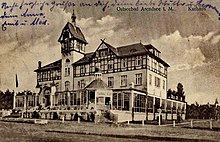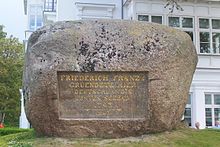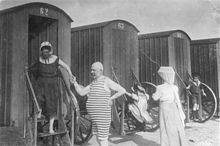Seaside resort

Seebad is a name for places with bathing culture and bathing tourism on the seashore. In Germany it is also a rating for health resorts that is awarded by the federal states. The prestigious title can be given to localities in which medical facilities are available for the implementation of spa measures . The predicate seaside resort also requires the use of the maritime climate in the spa.
For a list of the German seaside resorts, see the list of seaside resorts in Germany .
designation
Most of the German seaside resorts refer to themselves as the North Sea or the Baltic Sea depending on their location . This designation may be used in the place name, an example is the place Laboe on the east bank of the Kiel Fjord. Here on September 1st, 2004 the community name was renamed "Ostseebad Laboe" by the community council.
Sea baths that have the status of a medicinal bath are called sea spas .
Many seaside resorts have a tourist infrastructure . There are also seaside resorts on all of the inhabited German islands . The oldest German and continental European seaside resort is Heiligendamm , which is part of Bad Doberan in Mecklenburg .
history

Today the island pastor Gerhard Otto Christoph Janus of the North Sea island of Juist is considered to be the father of the seaside idea . In 1783 he had sent a petition to the Prussian King Frederick the Great and suggested the establishment of a seaside resort on Juist. The document is considered to be the oldest in German seaside resort history.
The first German seaside resort opened on September 21, 1793 on the Baltic Sea in Heiligendamm and the first North Sea resort opened on October 3, 1797 on Norderney .
As early as 1909, Meyer's Large Conversation Encyclopedia (Volume 18. Leipzig 1909, pp. 248–249) mentioned many seaside resorts:
- German Baltic seaside resorts: Binz , Heringsdorf , Sassnitz , Travemünde , Warnemünde and Zinnowitz ; as well as the former German seaside resorts of Cranz (today's Selenogradsk in Russia ), Misdroy , Swinoujscie and Sopot , which are now part of Poland .
- German North Sea baths: Amrun (today's spelling Amrum ), Borkum , Helgoland , Juist , Langeoog , Norderney , Spiekeroog , Wangeroog (today's spelling Wangerooge ), Wenningstedt , Westerland and Wyk auf Föhr .
- Holland: Scheveningen
- Belgium: Ostend
- France: Calais , Boulogne-sur-Mer , Dieppe , Trouville-sur-Mer , Cherbourg , Arcachon and Biarritz on the Atlantic Ocean ; on the Mediterranean Sea, Hyères , Cannes , Nice
- England: Margate , Dover , Folkestone , Hastings , Isle of Wight , Falmouth , Isles of Guernsey and Jersey ; Westward-Ho, Isle of Man .
- Austria: Abbazia (today Opatija in Croatia) and Ragusa (today Dubrovnik in Croatia)
For the summer half of 1936, the following overnight stays by foreigners (extract) were recorded for the German seaside resorts:
| Norderney | 550.203 |
| Kolberg (now in Poland) | 450.319 |
| Ahlbeck (Heringsdorf) | 417,447 |
| Swinoujscie (now in Poland) | 365,531 |
| Borkum | 357.845 |
| Brunshaupten | 335.015 |
| Cuxhaven | 306.032 |
| Westerland | 269,662 |
| Heligoland | 87,845 |
| place | since | region |
|---|---|---|
| Heiligendamm near Doberan | 1793 | Baltic Sea |
| Norderney | 1797 | North Sea |
| Lauterbach on Rügen | 1818 | Baltic Sea |
| Wyk on Föhr | 1819 | North Sea |
| Büsum | 1820 | North Sea |
| Heringsdorf on Usedom | 1825 | Baltic Sea |
| Heligoland | 1826 | North Sea |
| Westerland (Sylt) | 1855 | North Sea |
| Wenningstedt (Sylt) | 1857 | North Sea |
| Boltenhagen | 1803 | Baltic Sea |
| Travemünde | 1802 | Baltic Sea |
Criteria for awarding a rating
The recognition as a seaside resort is part of the health resort legislation that the state law is subject. The regulations can therefore differ from one another in the individual countries .
Baltic Sea
Mecklenburg-Western Pomerania
In the German state of Mecklenburg-Western Pomerania , the law on recognition as a health resort and recreation area (Kurortgesetz) applies . In this law, Section 3 defines the different types of health resorts, with a distinction being made between seaside resorts and seaside health resorts . The recognition expires after 30 years. It can be extended upon request.
Legal requirements for a seaside resort in Mecklenburg-Western Pomerania:
- Location on the seashore; the center of the village must not be more than two kilometers from the coastline
- climatic properties and air quality that are monitored and that support the possibilities of recovery and relaxation
- at least one doctor's office
- Perfect bathing water quality on a well-kept and guarded bathing beach that is monitored
- Beach promenades, parks that are sufficiently undisturbed by road traffic as well as beach or landscape paths, opportunities for games and sports
The prerequisites for a sea spa are defined as follows:
- Location on the seashore; the center of the village must not be more than two kilometers from the coastline
- Scientifically recognized and therapeutically applicable climate that has proven itself through experience and a corresponding air quality that is monitored
- at least one practice of a spa doctor
- Facilities for dispensing and using the cure products
- Perfect bathing water quality on a well-kept and guarded bathing beach that is monitored
- Beach promenades, parks that are sufficiently undisturbed by road traffic, as well as beach or landscape paths, opportunities for games and sports
- diet advice during the short term; Employment of at least one dietician in hospitals and diet kitchens
- Communication and information facility
North Sea Bath
- Health services
- Establishment of at least one spa doctor
- Joint responsibility for local health-promoting nutritional offers
- Facilities for first aid, rescue services and non-cure-specific care by doctors and pharmacists
- Possibly. medical-therapeutic infrastructure according to the recognized main therapeutic indications
- Bioclimate and air quality
- Favorable bioclimatic location
- Sufficient air quality and, for the indication "respiratory diseases", increased requirements for air quality
- Location, location and pollution
- Location on the seashore or in the immediate vicinity (distance from the center of the village or district max. 2 km from the beach)
- Ensuring the health resort character through:
- corresponding regional and land-use planning
- loosened development, embedded in horticultural and natural planting
- impeccable road, pedestrian, bike and hiking trail network
- Keeping the natural geogenic resources, the remedies, the climate and the surrounding landscape as well as the infrastructural and structural design and development of the site free from influences that can endanger, impair or destroy the character of health and recreation
- Special consideration of the needs of the handicapped
- Tourist infrastructure and leisure activities
- Creation of framework conditions for a relaxing stay in the accommodation facilities.
- Adequate provision and maintenance of public toilets
- Recognized tourist information
- Shelters in the beach area and rest facilities in sheltered areas.
- Promenades and hiking trails close to the beach.
- Well-kept and supervised bathing beach with qualitatively and quantitatively appropriate services and facilities.
- Cultural and other leisure-related events.
- Promotion of sporting and other health-related offers, sports and games, spa park, zone of calm.
- Ability to use media
- Special consideration of the needs of the handicapped
- Quality management
- Review of the quality standards of the spa and tourism organization (s) and their facilities by means of a quality management system every 5 years
- Regular meetings of all service providers to exchange sector-specific situation analyzes and the coordination of future-oriented developments
- Analyzes and reports
- For climate
- Climate assessment based on the preliminary assessment of the bioclimate and air quality
- Control of the bioclimatic influencing factors every 10 years for justified reasons
- Expert opinion on the air quality in the assessment area in accordance with the preliminary assessment
- For climate
North Sea spa
- Efficient facilities for the application of the therapeutic agent
- Differentiated system of health resort medical care structures with outpatient and / or inpatient treatment facilities with special consideration of the needs of physically handicapped people. Must be held:
- Device for dispensing at least one localized remedy and for applying general physical therapy with medical supervision.
- Requirements and facilities in the area of the beach zone and in wind-protected areas for controllable dosage of climatic stimuli.
- Facility and personnel for arranging nutrition and diet programs.
- Facilities for exercise therapy and other activating forms of treatment.
- Exercise and relaxation rooms for relaxation therapy concepts.
- Differentiated system of health resort medical care structures with outpatient and / or inpatient treatment facilities with special consideration of the needs of physically handicapped people. Must be held:
- Natural, scientifically proven remedies
- Occurrence and scientific assessment of the healing effects of the natural medicinal product of the sea
- Health services
- Establishment of at least one health resort doctor licensed by statutory health insurance, taking into account the criteria of the health resort doctor's contract.
- When carrying out outpatient cures: Consideration of the "Common principles for carrying out outpatient cures"
- When carrying out compact cures: Recognition by the committee for compact cures at the Westphalia-Lippe Association of Statutory Health Insurance Physicians.
- Joint responsibility for the psychological support of the spa patients
- Joint responsibility for local health-promoting nutritional offers
- Facilities for first aid, rescue services and non-cure-specific care by doctors and pharmacists
- Spa house for dispensing seawater baths, mud baths and packs as well as the application of general physical therapy
- Exercise therapy facilities
- Special health offers (e.g. Thalasso)
- Bioclimate and air quality
- Therapeutically applicable and proven bioclimate with the possibility of dosing the climatic stimuli
- Increased demands on air quality
- Location, location and pollution
- Location on the seashore or in the immediate vicinity (distance from the center of the village or district max. 2 km from the beach)
- Ensuring the health resort character through:
- corresponding regional and land-use planning
- loosened development, embedded in horticultural and natural planting
- impeccable road, pedestrian, bike and hiking trail network
- Keeping the natural geogenic resources, the remedies, the climate and the surrounding landscape as well as the infrastructural and structural design and development of the site free from influences that can endanger, impair or destroy the character of health and recreation
- Special consideration of the needs of physically handicapped people (1.3.7 a)
- Tourist infrastructure and leisure activities
- Creation of framework conditions for a relaxing stay in the accommodation facilities, especially classification
- Adequate provision and maintenance of public toilets
- Recognized tourist information
- Event and communication facilities with opportunities to linger
- Beach and park-like facilities
- Promenades near the beach, paths, hiking trails, facilities, lounge areas, shelters, plantings in the area of the standing zone and in wind-protected areas for controllable dosage of the climatic stimuli
- "Haus des Gastes" as a communication, information and training center for patients and spa guests
- Well-kept and supervised bathing beach with qualitatively and quantitatively appropriate services and facilities
- Bathing possibilities in the hall
- Sports and leisure facilities
- Cultural and other leisure-related events (e.g. spa music)
- Promotion of sporting and other health-related offers
- Ability to use media
- Special consideration of the needs of the handicapped
- Analyzes and reports
- Medical-scientific determination and recognition of therapeutic indications and contraindications through scientific reports
- For sea water:
- Scientific report on the therapeutic suitability of sea water by a medical-balneological institute or a medical-balneological expert
- Sea water analysis every 10 years
- Regular seawater control analyzes
- Monthly general hygiene checks
- Chemical control analysis in swimming pools and exercise pools as well as therapy pools of the treated bathing water at least every 2 years
- For climate:
- Medical and climatological report on the possibilities of recovery and recovery in the local bioclimate and its therapeutic uses
- Pre-assessment of the bio-climate and air quality
- Climate report on the therapeutic suitability of the bioclimate and the dosage options for climatic stimuli in the form of an extended climate analysis
- Control of the bioclimatic influencing factors every 10 years
- Expert opinion on the air quality in the assessment area
- Periodic review of air hygiene requirements every 5 years by means of a preliminary assessment
- Regular checking of the air quality through annual control measurements every 10 years
literature
- Olga Kurilo (Ed.): Seaside resorts on the Baltic Sea in the 19th and 20th centuries. Martin Meidenbauer, Munich 2009, ISBN 978-3-89975-151-2 . ( Review )
Web links
Individual evidence
- ^ Arnd Krüger : History of movement therapy, in: Preventive medicine . Springer, Heidelberg Loseblatt Collection 1999, 07.06, pp. 1–22.
- ↑ Meyers 1905
- ↑ Look it up! Bibliographisches Institut AG, Leipzig 1938, p. 321.
- ↑ Harry Kunz, Thomas Steensen: The new Sylt Lexikon . Ed .: Nordfriisk Instituut. 2nd Edition. Wachtholtz Verlag, Neumünster 2007, ISBN 978-3-529-05518-8 , p. 346 .
- ↑ Framework legislation

